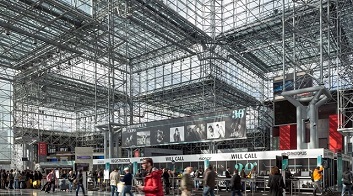 NEW YORK—New York Convention Center Operating Corporation (NYCCOC) President and CEO Alan Steel announced the issuance of the Javits Center’s first-ever Sustainability Report, which outlines the efforts to green the largest convention center in New York. The 31-page report details a host of sustainable initiatives implemented at the Javits Center, including a significant reduction in the building’s energy consumption, the creation of a wildlife sanctuary and the establishment of partnerships with educational and community institutions, as well as customers and other government organizations. To read the entire report, visit www.javitscenter.com.
NEW YORK—New York Convention Center Operating Corporation (NYCCOC) President and CEO Alan Steel announced the issuance of the Javits Center’s first-ever Sustainability Report, which outlines the efforts to green the largest convention center in New York. The 31-page report details a host of sustainable initiatives implemented at the Javits Center, including a significant reduction in the building’s energy consumption, the creation of a wildlife sanctuary and the establishment of partnerships with educational and community institutions, as well as customers and other government organizations. To read the entire report, visit www.javitscenter.com.
Since 2014, 26 bird species have been observed on or near the Javits Center’s 6.75-acre green roof, proving its status as a home for area wildlife in New York City. Six new bird species were identified in 2016, according to the New York City Audubon, which has conducted annual six-month surveys atop the convention center. The green roof also has demonstrated the capability of reducing storm water runoff. In partnership with New York City’s The Cooper Union for the Advancement of Science and Art and Drexel University of Philadelphia, climate stations have been installed on the green roof, and data collected so far indicate that the green roof is capable of retaining up to 7 million gallons of storm water on an annual basis, which is 81 percent of the mean event retention.
“From the installation of a giant green roof to new energy-efficient lighting, the Javits Center has made great strides in increasing its sustainability, and we are proud to issue our first Sustainability Report that details our progress so far,” said Alan Steel, President and CEO of the New York Convention Center Operating Corporation, which operates the Javits Center.
“The mission of the Javits Center is to spur economic activity, but we have to be more than just an economic engine,” Steel says. “We must be a community partner, and this report illustrates our efforts to improve the quality of life for our staff, customers and neighbors.”
A Haven for Birds
“No building in New York City has done more for the area’s bird populations than the Javits Center, and the results of our partnership reflect that commitment,” said Kathryn Heintz, Executive Director of New York City Audubon. “The green roof has proven to be a habitat for a community of birds, bats and insects in an area of New York City that lacks green space. With its large size and unique location, the Javits Center has become a prime example of the important benefit of sustainability. We would like to thank Alan Steel and his team for their ongoing contributions to the improvement and preservation of our natural environment.”
“The green roof has an enormous effect on energy reduction of the Javits Center and, quite frankly, is creating a new model for sustainability and urban infrastructure,” said Joseph C. Cataldo, P.E., Professor of Civil Engineering at Cooper Union. “The drop in temperatures of the green roof over the black roof has been approximately 30 degrees Fahrenheit. We have also seen an improvement of nearly 18 degrees over street level temperatures. The Javits Center should be commended for this commitment and I am looking forward to continuing its study.”
“Housing the second largest green roof in the country, the Javits Center has become a laboratory for Drexel students studying both the energy and water balance of this particular type of green infrastructure,“ said Franco Montalto, PhD, P.E., Associate Professor in the Department of Civil, Architectural and Environmental Engineering at Drexel University. “We are grateful for the opportunity to be able to monitor its environmental performance.”
A LEED Silver Building
The green roof, the second largest of its kind in the United States, and other sustainable upgrades were installed as part of a major renovation between 2009 and 2014 that earned the Javits Center LEED Silver Certification from the U.S. Green Building Council. Led by the New York Convention Center Development Corp., architectural firm FXFOWLE and Tishman Construction, the renovation included the installation of more than 6,000 translucent, bird-friendly glass panels, which have reduced bird collisions by 90 percent and created a healthier environment for staff, customers and local residents. More than 100 energy-efficient HVAC units, 425 Variable Air Volume (VAV) boxes and a new Building Management System also have been installed, enabling staff to better manage the building’s temperature and air flow from a single monitoring station. In order to build on this progress, Javits Center management has since focused on incorporating additional sustainable initiatives into its day-to-day operations, leading to many efforts described in the 2017 Sustainability Report. Among the achievements cited are:
· Wildlife sanctuary. There were 1,534 cumulative bird sightings on the green roof in 2016, according to the New York City Audubon. The green roof remains the only green roof in New York City with a colony of nesting Herring Gulls, which produced 24 chicks in 2016—a 71 percent increase compared to the previous year. In addition, five bat species and 12 orders of arthropods have been detected on the roof. The growing diversity of wildlife on the green roof demonstrates the importance of the building’s green roof to the community’s ecosystem.
· Demand response. With the use of two energy dashboards providing live consumption data, the Javits Center is enrolled in three demand response programs that ask customers to reduce energy consumption on days when there is a high demand on the electrical grid. During the summer of 2016 demand response period, the Javits Center reduced 4,400kWh during the event. This equates to the offset of power of more than 1 percent of the entire New York City load this past summer.
· Electricity reduction. From 2013 to 2016, the Javits Center has reduced electric consumption by 6,631,524 kilowatts/hour (kWh). This is the equivalent of 4,660 metric tons of carbon dioxide and is comparable to emissions from the burning of 4,973,171 pounds of coal. These initiatives have saved the Javits Center nearly two million dollars since 2013.
· New lighting. In 2016, LED (Lighting Emitting Diode) fixtures were installed in 47 janitor closets, 22 electrical closets, 13 data closets and eight information technology closets. These lamps were installed with occupancy sensors, reducing the amount of “on” hours from almost 24 hours a day to one hour a day.
· Pest management. In 2014, the Javits Center introduced several feral cats as a sustainable method to rid the facility’s loading docks of rodents. Cats reduced the need for exterminator services, and by working with the NYC Feral Cat Alliance, volunteers were able to find cats that were accustomed to living in high-traffic areas such as loading docks. This innovative program has become a great success, eliminating most rodents from the loading dock area and creating a healthier work environment for our employees, customers and business partners.
· Customer Collaboration. In 2016, 26 events submitted requests for sustainability reports, a significant increase that can be attributed to heightened awareness and shifting trends within the events industry. In 2017, the Javits Center will sub-meter all of its exhibition halls, and as a result, an even more accurate account of electric consumption will be collected and delivered to each customer who requests the information. After establishing a baseline during the first year of participation, event managers can establish goals during future events.
· New Training. In 2016, five Javits Center employees were trained in Level 1 Thermography. Knowing how to use infrared technology will help locate potential problems in equipment, improving preventative maintenance procedures. When a hot spot in mechanical equipment is detected, the machinery is often not running efficiently, and this can lead to larger issues, such as the replacement of entire systems. Periodic monitoring of mechanical equipment will become a part of the building’s overall maintenance program this year.
By creating a wildlife habitat, reducing the carbon footprint through comprehensive energy management, expanding partnerships with local universities, scientists and students and increasing employee and customer outreach, the Javits Center has quickly become an inspiration to other convention centers and buildings throughout New York and the country, earning awards from several organizations such as New York City Audubon and New York State Department of Environmental Conservation. Through its energy-saving programs, the Javits Center reduced its carbon footprint by 4,713,704 tons of CO2e (carbon dioxide equivalent) from 2015 to 2016—a remarkable achievement by any standard.
To provide a better understanding of its sustainable efforts, the Javits Center now offers free building tours throughout the year, and those interested can register at www.javitscenter.com.





